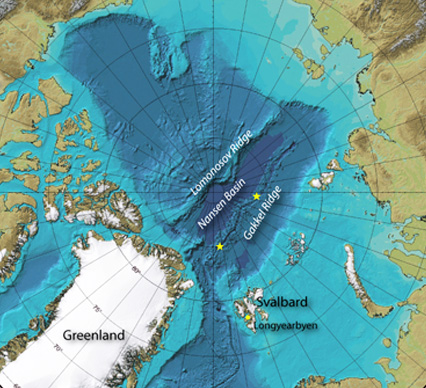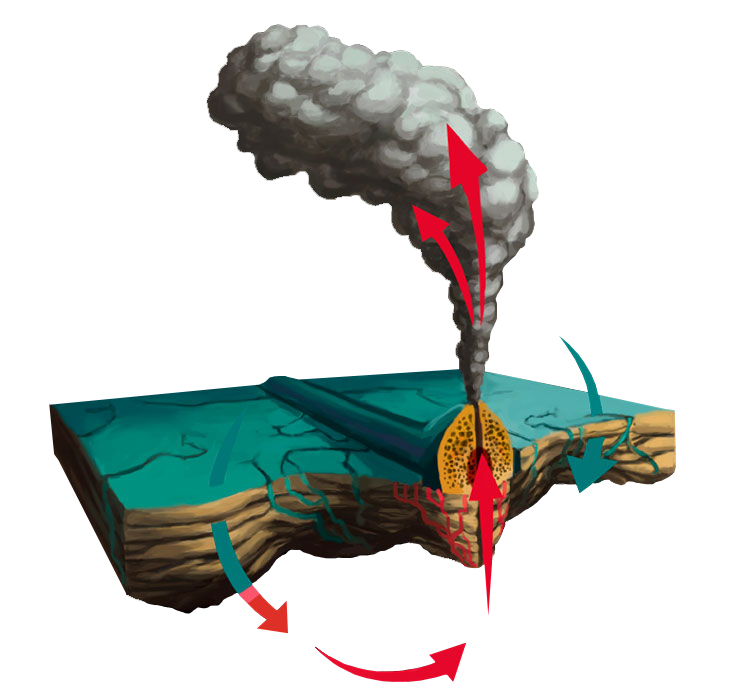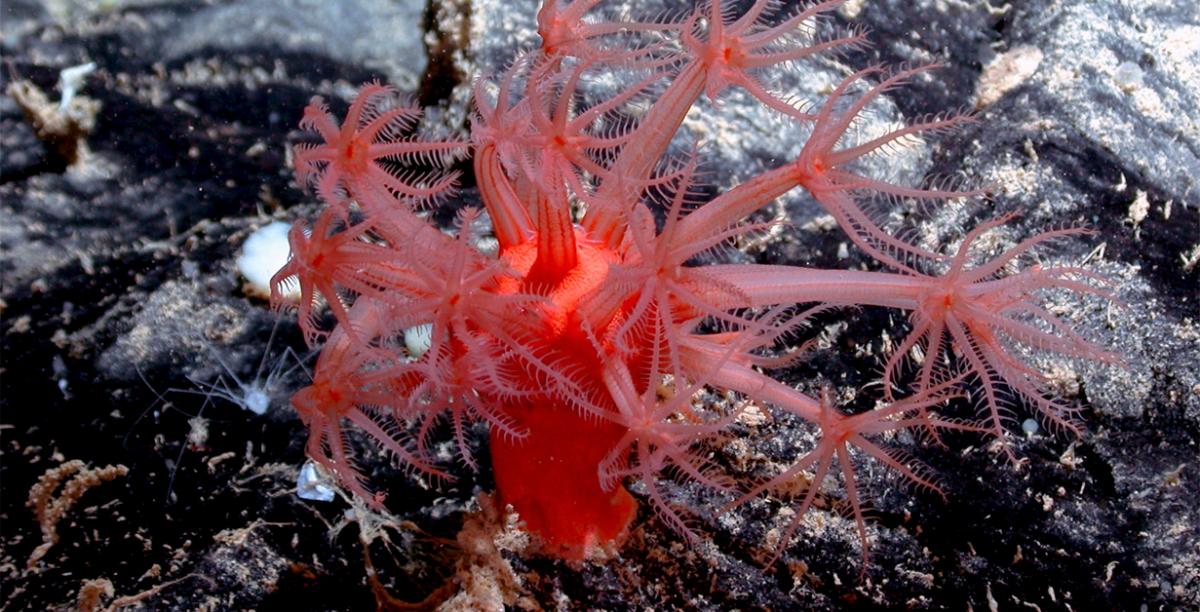
Hydrothermal vents at the sea floor offer clues to the origins of life on earth, and beyond.
Before life on earth, what was there?
To be alive is to ponder that question and, perhaps, its natural follow-up: Is there life on other planets too?
For Jill McDermott, such inquiries are more than theoretical. As a geochemist and field scientist who studies life at the seafloor, her work could lead to answers. McDermott collects and studies the liquid that shoots out of volcanic parts of the deep sea, called hydrothermal vents. The vibrant animal and microbial communities that live at the sea floor offer a glimpse into a world that may hold clues to the beginnings of life on earth.
“Hydrothermal vent ecosystems exist in permanent darkness,” says McDermott. “Understanding the chemical makeup of these unexplored waters offers a peek into how life survives without sunlight.”
Such an understanding could illuminate the origins of life—on earth, and beyond.
Gakkel Ridge, Europa and Enceladus

Gakkel Ridge is located in a particularly remote part of the Arctic between Greenland and Siberia. Researchers first found evidence of hydrothermal venting there in 2001.
Taking a trip to explore the arctic sea floor has a lot in common with space travel: it takes days to get there, can only be reached aboard a specialized vessel and is an unexplored frontier—one of earth’s last.
Another point of resemblance: the arctic environment may be similar to the surface of some moons.
That is the reason the National Aeronautics and Space Administration (NASA) has taken an interest in McDermott’s work. The agency co-funded an expedition last fall to a field location near the North Pole on board the Polarstern, a German icebreaker belonging to the Alfred Wegener Institute for Polar and Marine Research (AWI). An icebreaker is exactly what it sounds like—a highly specialized ship capable of breaking ice in order to move and navigate through ice-covered waters. McDermott was one of over 40 scientists who made the trip, which began at a port in Tromsø, Norway last September. Their destination: a remote part of the Arctic called Gakkel Ridge.
Gakkel Ridge, located between Greenland and Siberia, was long believed to be non-volcanic. Researchers first found evidence of volcanic activity in 1999 and of hydrothermal vents in 2001. Until the team aboard the Polarstern arrived, no one had explored the target area in 10 years.
McDermott was among a team of chemical and biological scientists there to explore and map the area, collect water samples emitted from the vents, and examine the novel geochemistry and microbial life contained therein. Multiple lines of evidence show that the team successfully obtained samples from within 200 meters of the deep seafloor vent source—closer than anyone is believed to have reached.
Describing the seven weeks aboard the Polarstern—around two weeks of transit and five weeks on station—McDermott laughs, saying: “It’s like taking a trip to the moon.” Once they reached the Arctic, the ship spent days breaking through ice as thick as 1.5 meters (about 5 feet) to reach their first destination.
McDermott collecting ice core samples from arctic glaciers in front of the Polarstern, a German icebreaker belonging to the Alfred Wegener Institute for Polar and Marine Research (AWI). Photo courtesy of Jill McDermott.
It is exactly this environment—a liquid water ocean overlaid by an icy shell—that makes the Arctic deep sea of interest to NASA. Over the past several years, NASA’s Hubble Space Telescope imaged possible plumes of water vapor erupting off the surface of Europa, one of Jupiter’s moons. That discovery has put Europa on a short list of bodies in the outer solar system that could support life. During its 13 years orbiting Saturn, Cassini captured a similar phenomenon at the South Pole of Enceladus, one of Saturn’s moons. Cassini data indicate that the geyser-like plumes may be from hydrothermal vents, and that energy sources for microbial life may exist on Enceladus.
McDermott and NASA have a few questions in common about hydrothermal vents, including: What makes such an environment habitable? How much life is there? And, what is it doing?
What are hydrothermal vents?

Sea water seeps through cracks in the sea floor, is heated by the magma chamber, becomes buoyant and is expelled back up like a spring, creating a plume of “chemical soup.” Credit: Spencer Sutton/SCIENCE PHOTO LIBRARY
Hydrothermal vents flow up through cracks at the bottom of the ocean which, much like hot springs on land, spout mineral-rich liquid that has been heated beneath the sea floor.
First discovered in 1977—by, among others, the supervisor of McDermott’s future grad thesis advisor at the Massachusetts Institute of Technology (M.I.T.)—hydrothermal vents were found to be populated by previously unknown organisms in a novel environment. According to the Woods Hole Oceanographic Institute, the largest independent oceanographic research institution in the U.S. and a partner in McDermott’s research, “These discoveries fundamentally changed our understanding of Earth and life on it.”
Hydrothermal vents are found around the world, most often in volcanically active locations along the global mid-ocean ridge system. Volcanic activity, driven by upwellings of heat in Earth’s mantle, causes the brittle tectonic plates that make up Earth’s outer shell to split and spread apart. As the plates spread, new seafloor rock is formed by volcanic eruptions. This volcanic and tectonic activity creates cracks through which deep sea water seeps into the rocks.
The water, which at the sea floor is 2 degrees Celsius (about 35 degrees Fahrenheit), makes its way through the cracks toward a heat source, called the magma chamber, which can sit about 1 to 2 kilometers (about 3,000 to 6,000 feet) below the seafloor in some systems. The rock surrounding the magma chamber is very hot, and heats the water. The temperature of these fluids could exceed 400 degrees Celsius or 700 degrees Fahrenheit, which is more than four times the boiling point of water at Earth’s surface.
“The seawater undergoes chemical reaction with the basaltic or ultramafic rock,” explains McDermott. “At that point, the sea water has been transformed into a hydrothermal fluid. It is not sea water anymore.”
The chemical transformation process that occurs when ultramafic rock comes into contact with water is called serpentinization. Many scientists wonder whether serpentinizing hydrothermal systems played a role in spawning life on earth.
As the transformed water heats up beneath the seafloor, it becomes buoyant and is expelled back up like a spring, creating a plume of “chemical soup.”
The time between volcanic eruptions varies widely depending on the system, says McDermott, with some systems erupting every decade, others every 10,000 years. However, even in the interim times between volcanic eruptions, submarine hydrothermal springs continually flow through the seafloor rocks, and cycle up to the seafloor.
Understanding the chemistry that supports life in hydrothermal vents
During the expedition, a remotely operated vehicle roamed the sea floor in tandem with towed sensors and water bottles, collecting samples that McDermott, on board the Polarstern, would immediately examine for methane to gauge the vent location. The more methane detected, the closer they were to the vent origin. After the trip, the samples were transferred to the laboratory for further study.
What is she looking for?
“We know that hydrothermal vents are permeated with life and that this life is dependent on chemistry,” she says. “I am particularly interested in measuring the levels of methane and hydrogen, as these could potentially support life in the Arctic vent plume.”

Hydrothermal vents host vibrant animal communities such as this anemone that lives in "permanent darkness" at the sea floor. Credit: B. Murton/Southampton Oceanography Centre/ Science Photo Library
When they are expelled at the seafloor, hydrothermal vent waters are enriched in methane and hydrogen, especially the very energy-rich free molecular hydrogen, which can serve as fuel for microbes. Interestingly, free hydrogen has been found in the plumes of liquid spouting from Saturn’s moon Enceladus.
The fact that this "life in the dark" is among the most poorly understood on the planet is reason enough to study it—though there are others: These deep-sea ecosystems have much to teach about how life is sustained below the reach of the sun’s energy—both in our ancient oceans and in the modern day. Because deep seawater is not warmed by the sun it remains at a consistent 2 to 4 degrees Celsius (35.6 to 39.2 Fahrenheit). Relative to the shallow ocean, the deep sea is a stable environment, and on human timescales it is largely immune to the impacts of extreme changes in climate that have affected and continue to affect the ocean closer to the surface.
“The vent fluid chemistry has profound effects on ocean water and offers a rare glimpse into microbial life that may have lived in places like these since the first oceans formed 3.8 billion years ago,” says McDermott. “The whole system is dependent on chemical energy rather than sunlight.”
At her Lehigh lab, McDermott examines the samples for clues about the chemical energy that makes life possible. She is most interested in how the chemicals are being formed: biotically, from living or once-living materials, or abiotically, in the absence of life.
“There is a lot of chemical potential in the vents to form organic molecules, containing carbon and hydrogen, either abiotically or biotically through microbial activity,” says McDermott. “Are these molecules found in the absence of life? The transition between abiotic to biotic interests me most.”
She wants to know: which molecules are here because of the living material that was already present and which, if any, developed from nonliving material?
The answer to that question is the “holy grail” of her field: defining abiotic pathways to create organic molecules, derived in the absence of the life. Such molecules, termed “probiotic chemistry” are an important precursor step along the pathway to form the complicated molecules that make up living things.
Has any evidence of such prebiotic molecules been found in hydrothermal vents on earth or elsewhere?
“There is strong evidence for the abiotic production of methane, hydrocarbons and a simple organic acid in hydrothermal vent settings,” says McDermott. “But as for more complex molecules, not yet. They are either absent, in low abundance, or have yet to be discovered.”
Nereid Under-Ice: a one-of-a-kind underwater robot
The hydrothermal vents at the Karasik Seamount of Gakkel Ridge are around 3,100 meters (more than 10,000 feet) below the ocean’s surface.
There is only one remotely operated vehicle (ROV) capable of navigating ice-covered water and sampling vents that far down: the Nereid Under-Ice.
A highly specialized underwater robot, Woods Hole Oceanographic Institution’s Nereid Under-Ice is built to travel up to 40 kilometers (25 miles) laterally underwater while still receiving control signals and transmitting data, including high-definition video, back to operators located on a ship via a hair-thin fiber-optic tether. The vehicle can dive up to 2,000 meters (6,500 feet) beneath the surface to sample or survey the ice-water interface, the mid-water or the seafloor. Last year’s Arctic trip was the second successful expedition for this deep-sea submarine to the Arctic sea floor.
The Polarstern team also used a conductivity temperature depth (CTD) rosette, which senses and determines the properties of sea water by measuring temperature, salinity and density.
This video includes footage recorded by the Nereid Under-Ice of deep sea life as well as the sampling process. Credit: Woods Hole Oceanographic Institution.
McDermott is among the first to sample and study the plumes from the hydrothermal vents at Gakkel Ridge. Though still early in the research, she and her colleagues will contribute significant new information. In a paper in preparation on the first results of the project, McDermott reports that Gakkel Ridge vent fluid chemistries share commonalities with the Lost City hydrothermal field on the Mid Atlantic Ridge and the Von Damm vent field at the Mid-Cayman Rise, revealing a new ice-covered ecosystem that is ripe for the study of life and other processes driven by abiotic production of methane and hydrogen by serpentinization.
Her team’s analysis of vent fluids revealed evidence for high temperature, hydrogen-rich, likely ultramafic-influenced seafloor venting. The team also observed abundant active microbial populations in the samples and, through analysis, will be able to predict the nature of the vent-fluid source as well as identify the fate of the fluid as it gets dispersed into the surrounding ocean and overlying ice.
Among the most compelling results she has found so far: the samples closest to the source contain an equivalent amount of methane and hydrogen.
“This implies that the hydrogen supply from the abiotic vent fluid source exceeds the rate of drawdown by micro-organisms in the plume, at least initially. How long does it take for this hydrogen to be consumed by microbes, and how far away from the source can it get?” she asks.
Those questions can now be added to the myriad others about these systems. With all their potential to illuminate the sources of energy for life on earth and elsewhere, for now, hydrothermal vents offer more questions than answers.
Unwittingly identifying another similarity between her expedition and space exploration, McDermott remarks: “The Arctic is a very mysterious place.”
Reprinted here from: https://www1.lehigh.edu/news/arctic-sea-expedition-hydrothermal-vents
